Contract and Consumer Law: Case Studies and Legal Principles Report
VerifiedAdded on 2020/02/24
|8
|1533
|279
Report
AI Summary
This report provides a comprehensive analysis of contract and consumer law, focusing on two key areas: contract law and Australian Consumer Law (ACL). The contract law section examines a scenario where a car owner seeks compensation from a parking lot for a stolen vehicle, exploring issues of exclusion clauses and their validity based on established legal precedents like L’Estange v Graucob and Olley v Marlborough Court Ltd. The analysis assesses whether the parking lot's exclusion clause was effectively communicated and whether it can negate liability for negligence. The ACL section analyzes two scenarios. Part A evaluates whether an advertisement made by a hotel owner, Tony, complies with Section 18 of the ACL, which prohibits misleading and deceptive conduct, referencing cases such as ACCC v Telstra Corporation Limited and Gillette Australia Pty Ltd v Energizer Australia Pty Ltd. Part B assesses Tony's plan to offer holidays to the elderly, considering whether his actions would constitute unconscionable conduct under Section 20 of the ACL, particularly concerning vulnerable consumers. The report concludes with a summary of the findings, including the ineffectiveness of the exclusion clause and the non-compliance of Tony’s actions with the ACL.
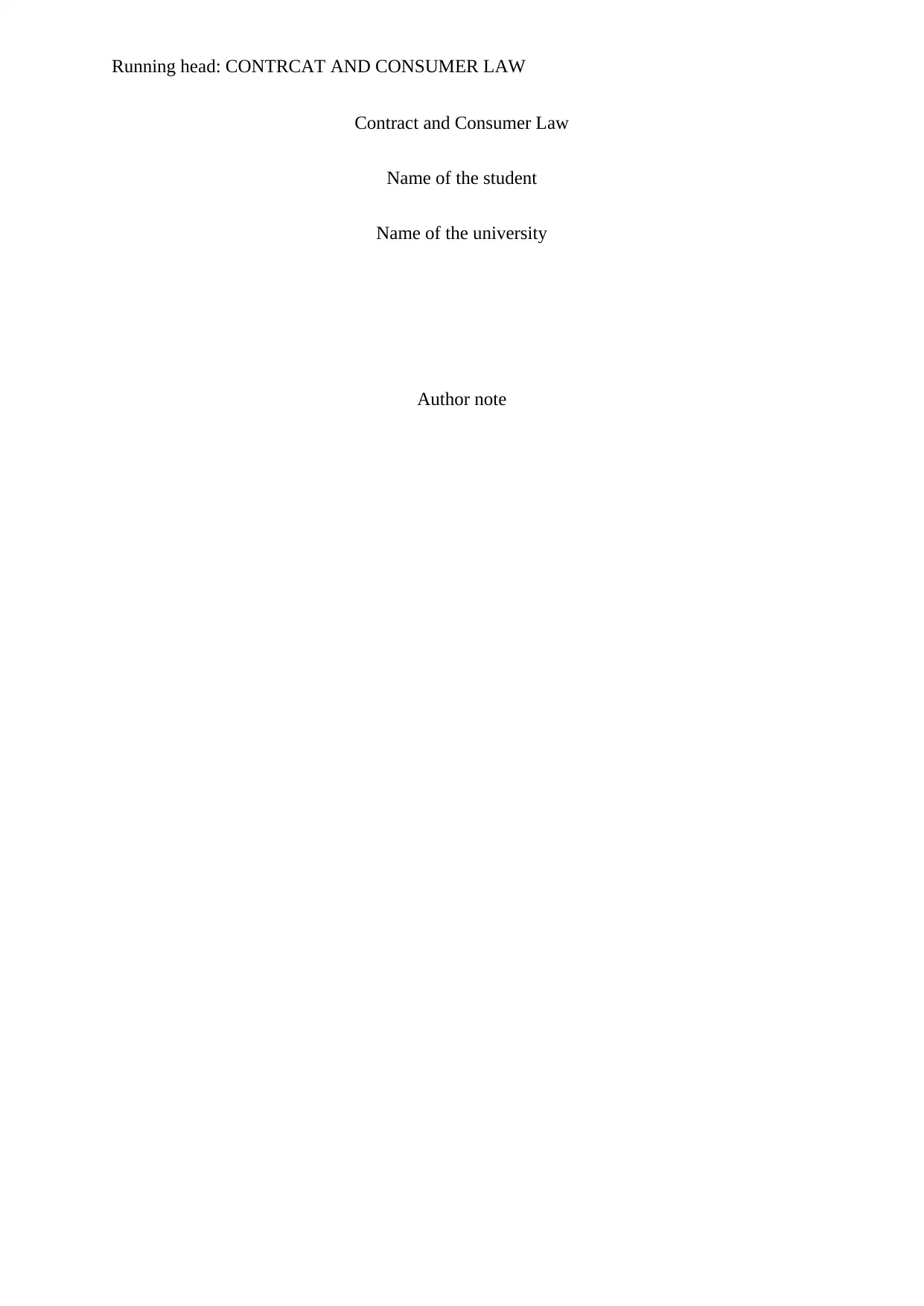
Running head: CONTRCAT AND CONSUMER LAW
Contract and Consumer Law
Name of the student
Name of the university
Author note
Contract and Consumer Law
Name of the student
Name of the university
Author note
Paraphrase This Document
Need a fresh take? Get an instant paraphrase of this document with our AI Paraphraser
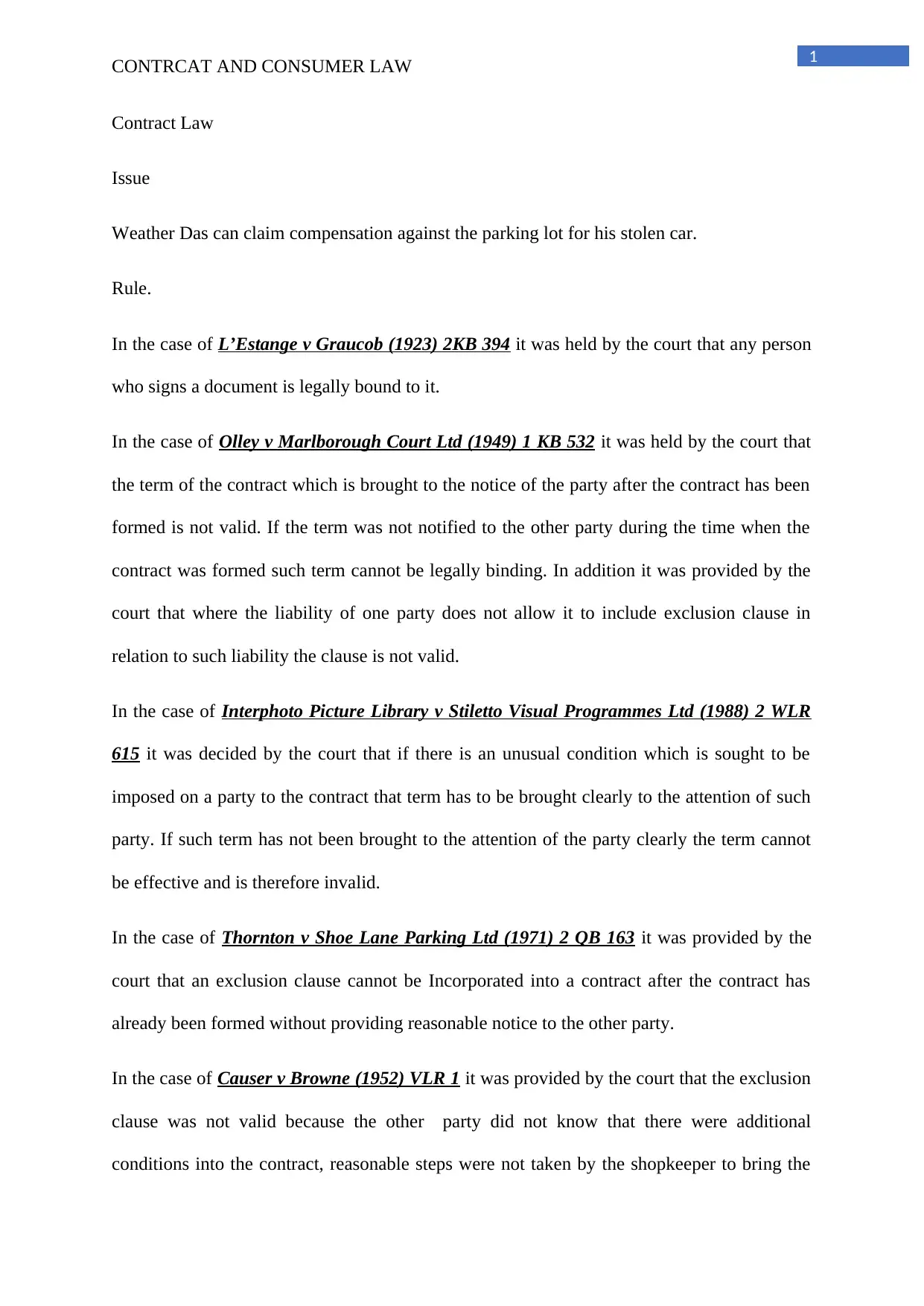
1
CONTRCAT AND CONSUMER LAW
Contract Law
Issue
Weather Das can claim compensation against the parking lot for his stolen car.
Rule.
In the case of L’Estange v Graucob (1923) 2KB 394 it was held by the court that any person
who signs a document is legally bound to it.
In the case of Olley v Marlborough Court Ltd (1949) 1 KB 532 it was held by the court that
the term of the contract which is brought to the notice of the party after the contract has been
formed is not valid. If the term was not notified to the other party during the time when the
contract was formed such term cannot be legally binding. In addition it was provided by the
court that where the liability of one party does not allow it to include exclusion clause in
relation to such liability the clause is not valid.
In the case of Interphoto Picture Library v Stiletto Visual Programmes Ltd (1988) 2 WLR
615 it was decided by the court that if there is an unusual condition which is sought to be
imposed on a party to the contract that term has to be brought clearly to the attention of such
party. If such term has not been brought to the attention of the party clearly the term cannot
be effective and is therefore invalid.
In the case of Thornton v Shoe Lane Parking Ltd (1971) 2 QB 163 it was provided by the
court that an exclusion clause cannot be Incorporated into a contract after the contract has
already been formed without providing reasonable notice to the other party.
In the case of Causer v Browne (1952) VLR 1 it was provided by the court that the exclusion
clause was not valid because the other party did not know that there were additional
conditions into the contract, reasonable steps were not taken by the shopkeeper to bring the
CONTRCAT AND CONSUMER LAW
Contract Law
Issue
Weather Das can claim compensation against the parking lot for his stolen car.
Rule.
In the case of L’Estange v Graucob (1923) 2KB 394 it was held by the court that any person
who signs a document is legally bound to it.
In the case of Olley v Marlborough Court Ltd (1949) 1 KB 532 it was held by the court that
the term of the contract which is brought to the notice of the party after the contract has been
formed is not valid. If the term was not notified to the other party during the time when the
contract was formed such term cannot be legally binding. In addition it was provided by the
court that where the liability of one party does not allow it to include exclusion clause in
relation to such liability the clause is not valid.
In the case of Interphoto Picture Library v Stiletto Visual Programmes Ltd (1988) 2 WLR
615 it was decided by the court that if there is an unusual condition which is sought to be
imposed on a party to the contract that term has to be brought clearly to the attention of such
party. If such term has not been brought to the attention of the party clearly the term cannot
be effective and is therefore invalid.
In the case of Thornton v Shoe Lane Parking Ltd (1971) 2 QB 163 it was provided by the
court that an exclusion clause cannot be Incorporated into a contract after the contract has
already been formed without providing reasonable notice to the other party.
In the case of Causer v Browne (1952) VLR 1 it was provided by the court that the exclusion
clause was not valid because the other party did not know that there were additional
conditions into the contract, reasonable steps were not taken by the shopkeeper to bring the
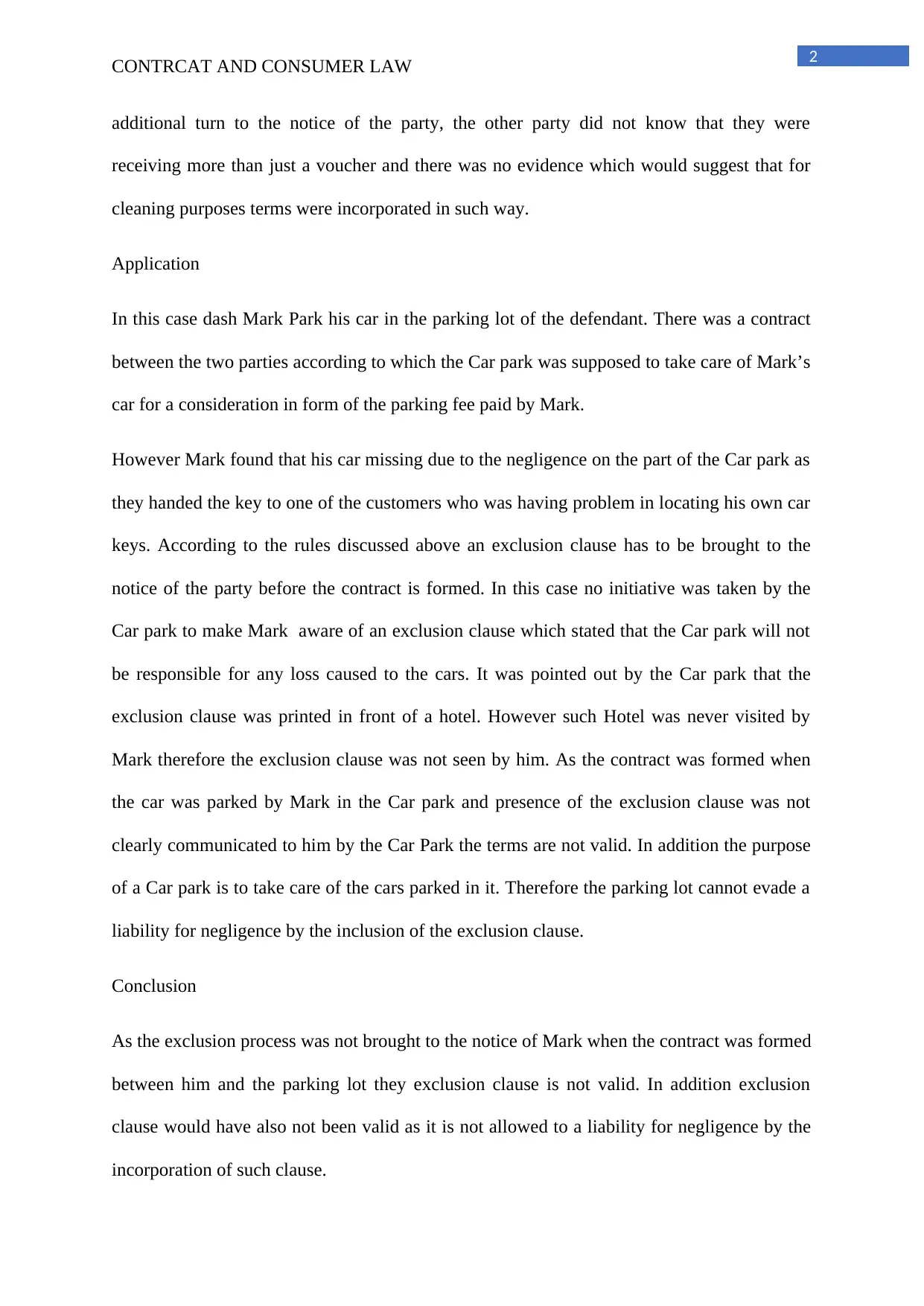
2
CONTRCAT AND CONSUMER LAW
additional turn to the notice of the party, the other party did not know that they were
receiving more than just a voucher and there was no evidence which would suggest that for
cleaning purposes terms were incorporated in such way.
Application
In this case dash Mark Park his car in the parking lot of the defendant. There was a contract
between the two parties according to which the Car park was supposed to take care of Mark’s
car for a consideration in form of the parking fee paid by Mark.
However Mark found that his car missing due to the negligence on the part of the Car park as
they handed the key to one of the customers who was having problem in locating his own car
keys. According to the rules discussed above an exclusion clause has to be brought to the
notice of the party before the contract is formed. In this case no initiative was taken by the
Car park to make Mark aware of an exclusion clause which stated that the Car park will not
be responsible for any loss caused to the cars. It was pointed out by the Car park that the
exclusion clause was printed in front of a hotel. However such Hotel was never visited by
Mark therefore the exclusion clause was not seen by him. As the contract was formed when
the car was parked by Mark in the Car park and presence of the exclusion clause was not
clearly communicated to him by the Car Park the terms are not valid. In addition the purpose
of a Car park is to take care of the cars parked in it. Therefore the parking lot cannot evade a
liability for negligence by the inclusion of the exclusion clause.
Conclusion
As the exclusion process was not brought to the notice of Mark when the contract was formed
between him and the parking lot they exclusion clause is not valid. In addition exclusion
clause would have also not been valid as it is not allowed to a liability for negligence by the
incorporation of such clause.
CONTRCAT AND CONSUMER LAW
additional turn to the notice of the party, the other party did not know that they were
receiving more than just a voucher and there was no evidence which would suggest that for
cleaning purposes terms were incorporated in such way.
Application
In this case dash Mark Park his car in the parking lot of the defendant. There was a contract
between the two parties according to which the Car park was supposed to take care of Mark’s
car for a consideration in form of the parking fee paid by Mark.
However Mark found that his car missing due to the negligence on the part of the Car park as
they handed the key to one of the customers who was having problem in locating his own car
keys. According to the rules discussed above an exclusion clause has to be brought to the
notice of the party before the contract is formed. In this case no initiative was taken by the
Car park to make Mark aware of an exclusion clause which stated that the Car park will not
be responsible for any loss caused to the cars. It was pointed out by the Car park that the
exclusion clause was printed in front of a hotel. However such Hotel was never visited by
Mark therefore the exclusion clause was not seen by him. As the contract was formed when
the car was parked by Mark in the Car park and presence of the exclusion clause was not
clearly communicated to him by the Car Park the terms are not valid. In addition the purpose
of a Car park is to take care of the cars parked in it. Therefore the parking lot cannot evade a
liability for negligence by the inclusion of the exclusion clause.
Conclusion
As the exclusion process was not brought to the notice of Mark when the contract was formed
between him and the parking lot they exclusion clause is not valid. In addition exclusion
clause would have also not been valid as it is not allowed to a liability for negligence by the
incorporation of such clause.
⊘ This is a preview!⊘
Do you want full access?
Subscribe today to unlock all pages.

Trusted by 1+ million students worldwide
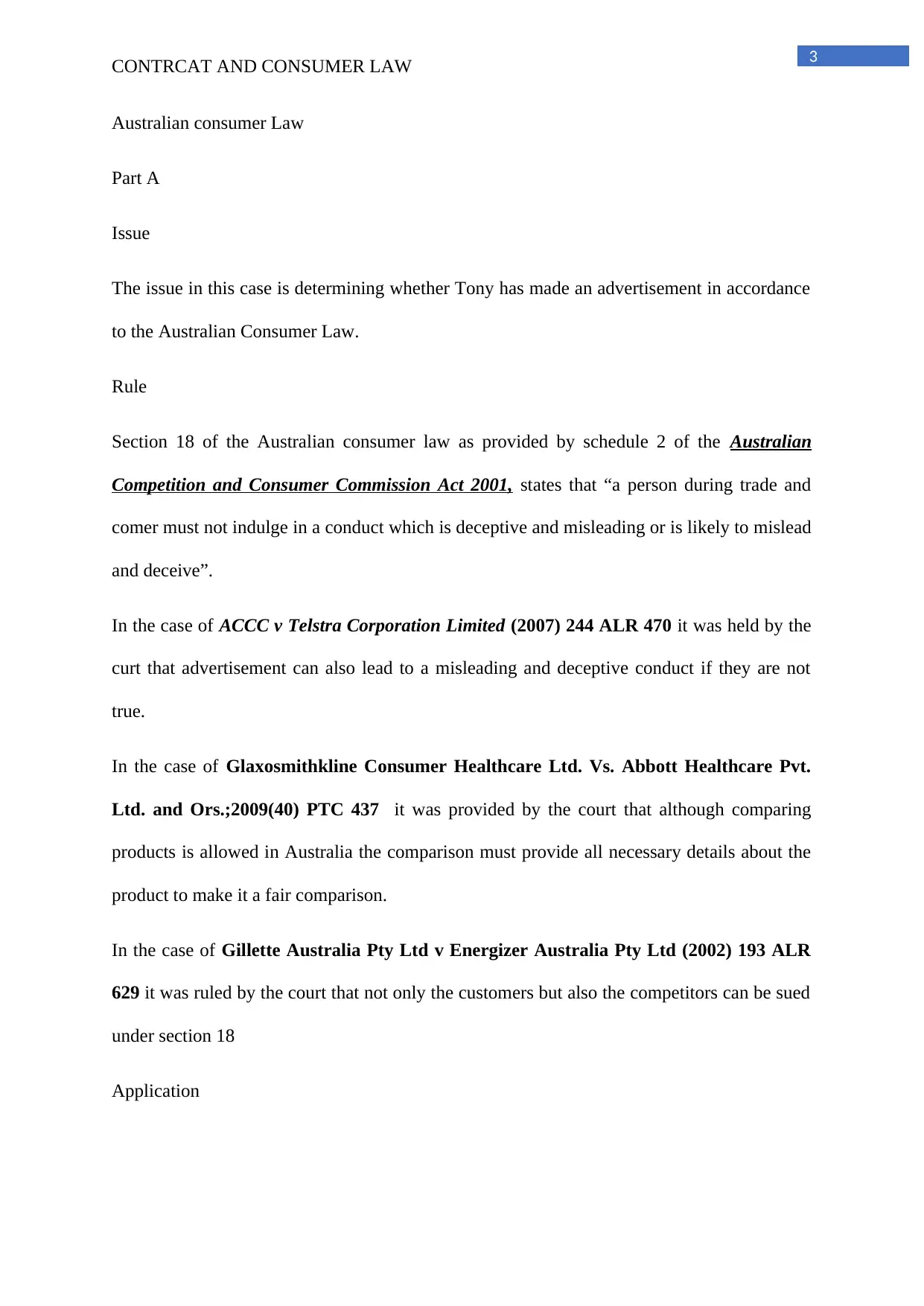
3
CONTRCAT AND CONSUMER LAW
Australian consumer Law
Part A
Issue
The issue in this case is determining whether Tony has made an advertisement in accordance
to the Australian Consumer Law.
Rule
Section 18 of the Australian consumer law as provided by schedule 2 of the Australian
Competition and Consumer Commission Act 2001, states that “a person during trade and
comer must not indulge in a conduct which is deceptive and misleading or is likely to mislead
and deceive”.
In the case of ACCC v Telstra Corporation Limited (2007) 244 ALR 470 it was held by the
curt that advertisement can also lead to a misleading and deceptive conduct if they are not
true.
In the case of Glaxosmithkline Consumer Healthcare Ltd. Vs. Abbott Healthcare Pvt.
Ltd. and Ors.;2009(40) PTC 437 it was provided by the court that although comparing
products is allowed in Australia the comparison must provide all necessary details about the
product to make it a fair comparison.
In the case of Gillette Australia Pty Ltd v Energizer Australia Pty Ltd (2002) 193 ALR
629 it was ruled by the court that not only the customers but also the competitors can be sued
under section 18
Application
CONTRCAT AND CONSUMER LAW
Australian consumer Law
Part A
Issue
The issue in this case is determining whether Tony has made an advertisement in accordance
to the Australian Consumer Law.
Rule
Section 18 of the Australian consumer law as provided by schedule 2 of the Australian
Competition and Consumer Commission Act 2001, states that “a person during trade and
comer must not indulge in a conduct which is deceptive and misleading or is likely to mislead
and deceive”.
In the case of ACCC v Telstra Corporation Limited (2007) 244 ALR 470 it was held by the
curt that advertisement can also lead to a misleading and deceptive conduct if they are not
true.
In the case of Glaxosmithkline Consumer Healthcare Ltd. Vs. Abbott Healthcare Pvt.
Ltd. and Ors.;2009(40) PTC 437 it was provided by the court that although comparing
products is allowed in Australia the comparison must provide all necessary details about the
product to make it a fair comparison.
In the case of Gillette Australia Pty Ltd v Energizer Australia Pty Ltd (2002) 193 ALR
629 it was ruled by the court that not only the customers but also the competitors can be sued
under section 18
Application
Paraphrase This Document
Need a fresh take? Get an instant paraphrase of this document with our AI Paraphraser
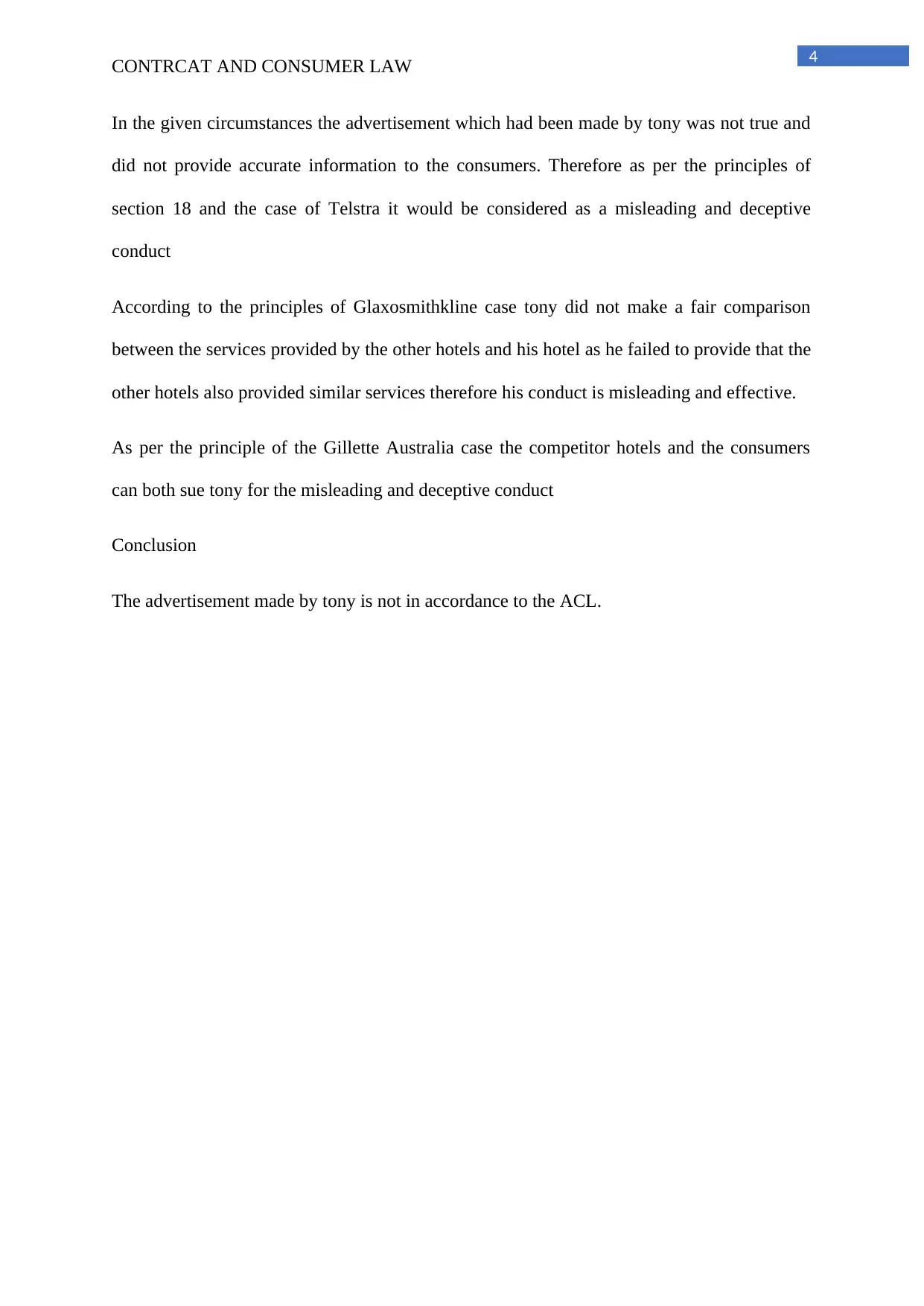
4
CONTRCAT AND CONSUMER LAW
In the given circumstances the advertisement which had been made by tony was not true and
did not provide accurate information to the consumers. Therefore as per the principles of
section 18 and the case of Telstra it would be considered as a misleading and deceptive
conduct
According to the principles of Glaxosmithkline case tony did not make a fair comparison
between the services provided by the other hotels and his hotel as he failed to provide that the
other hotels also provided similar services therefore his conduct is misleading and effective.
As per the principle of the Gillette Australia case the competitor hotels and the consumers
can both sue tony for the misleading and deceptive conduct
Conclusion
The advertisement made by tony is not in accordance to the ACL.
CONTRCAT AND CONSUMER LAW
In the given circumstances the advertisement which had been made by tony was not true and
did not provide accurate information to the consumers. Therefore as per the principles of
section 18 and the case of Telstra it would be considered as a misleading and deceptive
conduct
According to the principles of Glaxosmithkline case tony did not make a fair comparison
between the services provided by the other hotels and his hotel as he failed to provide that the
other hotels also provided similar services therefore his conduct is misleading and effective.
As per the principle of the Gillette Australia case the competitor hotels and the consumers
can both sue tony for the misleading and deceptive conduct
Conclusion
The advertisement made by tony is not in accordance to the ACL.
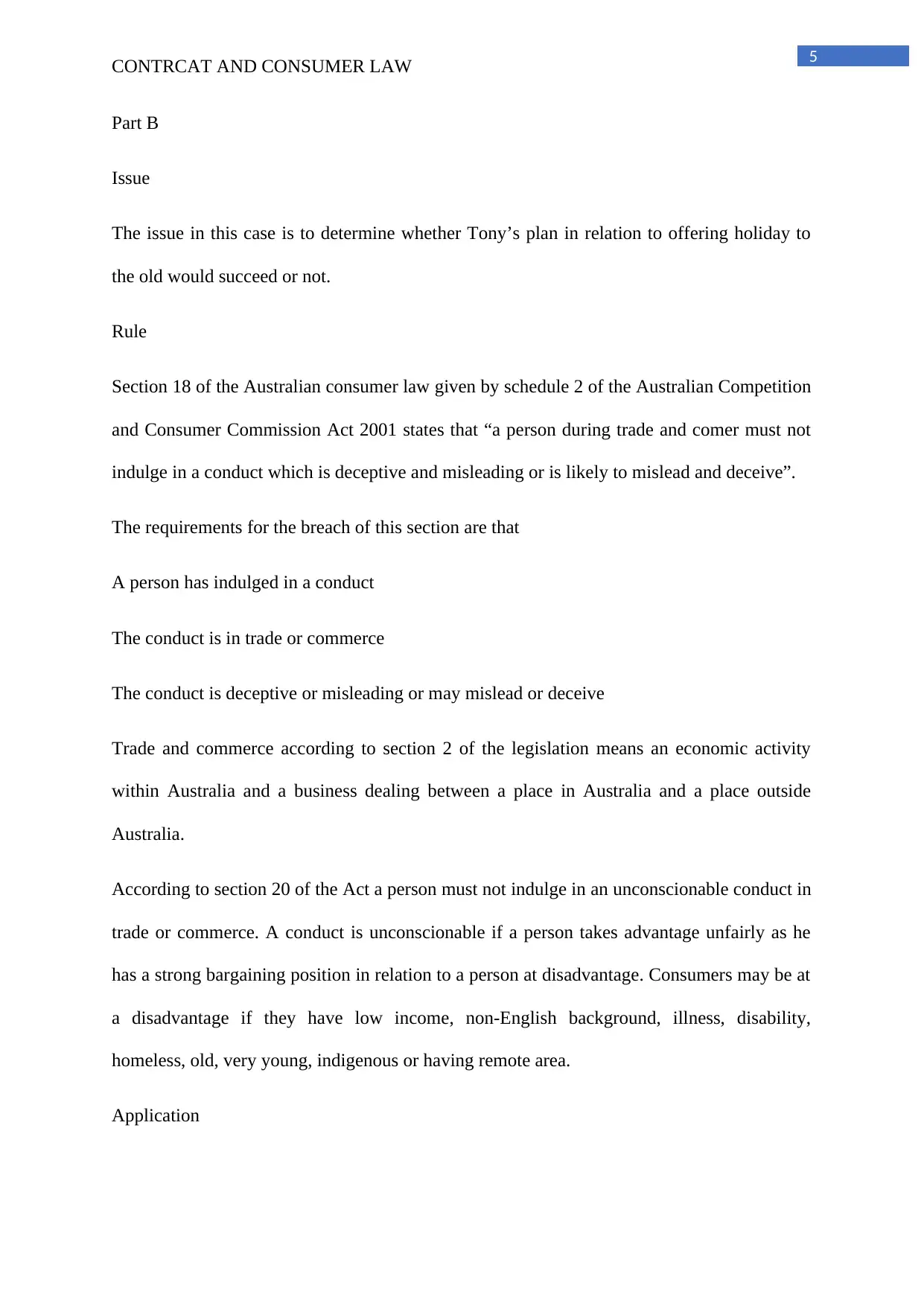
5
CONTRCAT AND CONSUMER LAW
Part B
Issue
The issue in this case is to determine whether Tony’s plan in relation to offering holiday to
the old would succeed or not.
Rule
Section 18 of the Australian consumer law given by schedule 2 of the Australian Competition
and Consumer Commission Act 2001 states that “a person during trade and comer must not
indulge in a conduct which is deceptive and misleading or is likely to mislead and deceive”.
The requirements for the breach of this section are that
A person has indulged in a conduct
The conduct is in trade or commerce
The conduct is deceptive or misleading or may mislead or deceive
Trade and commerce according to section 2 of the legislation means an economic activity
within Australia and a business dealing between a place in Australia and a place outside
Australia.
According to section 20 of the Act a person must not indulge in an unconscionable conduct in
trade or commerce. A conduct is unconscionable if a person takes advantage unfairly as he
has a strong bargaining position in relation to a person at disadvantage. Consumers may be at
a disadvantage if they have low income, non-English background, illness, disability,
homeless, old, very young, indigenous or having remote area.
Application
CONTRCAT AND CONSUMER LAW
Part B
Issue
The issue in this case is to determine whether Tony’s plan in relation to offering holiday to
the old would succeed or not.
Rule
Section 18 of the Australian consumer law given by schedule 2 of the Australian Competition
and Consumer Commission Act 2001 states that “a person during trade and comer must not
indulge in a conduct which is deceptive and misleading or is likely to mislead and deceive”.
The requirements for the breach of this section are that
A person has indulged in a conduct
The conduct is in trade or commerce
The conduct is deceptive or misleading or may mislead or deceive
Trade and commerce according to section 2 of the legislation means an economic activity
within Australia and a business dealing between a place in Australia and a place outside
Australia.
According to section 20 of the Act a person must not indulge in an unconscionable conduct in
trade or commerce. A conduct is unconscionable if a person takes advantage unfairly as he
has a strong bargaining position in relation to a person at disadvantage. Consumers may be at
a disadvantage if they have low income, non-English background, illness, disability,
homeless, old, very young, indigenous or having remote area.
Application
⊘ This is a preview!⊘
Do you want full access?
Subscribe today to unlock all pages.

Trusted by 1+ million students worldwide
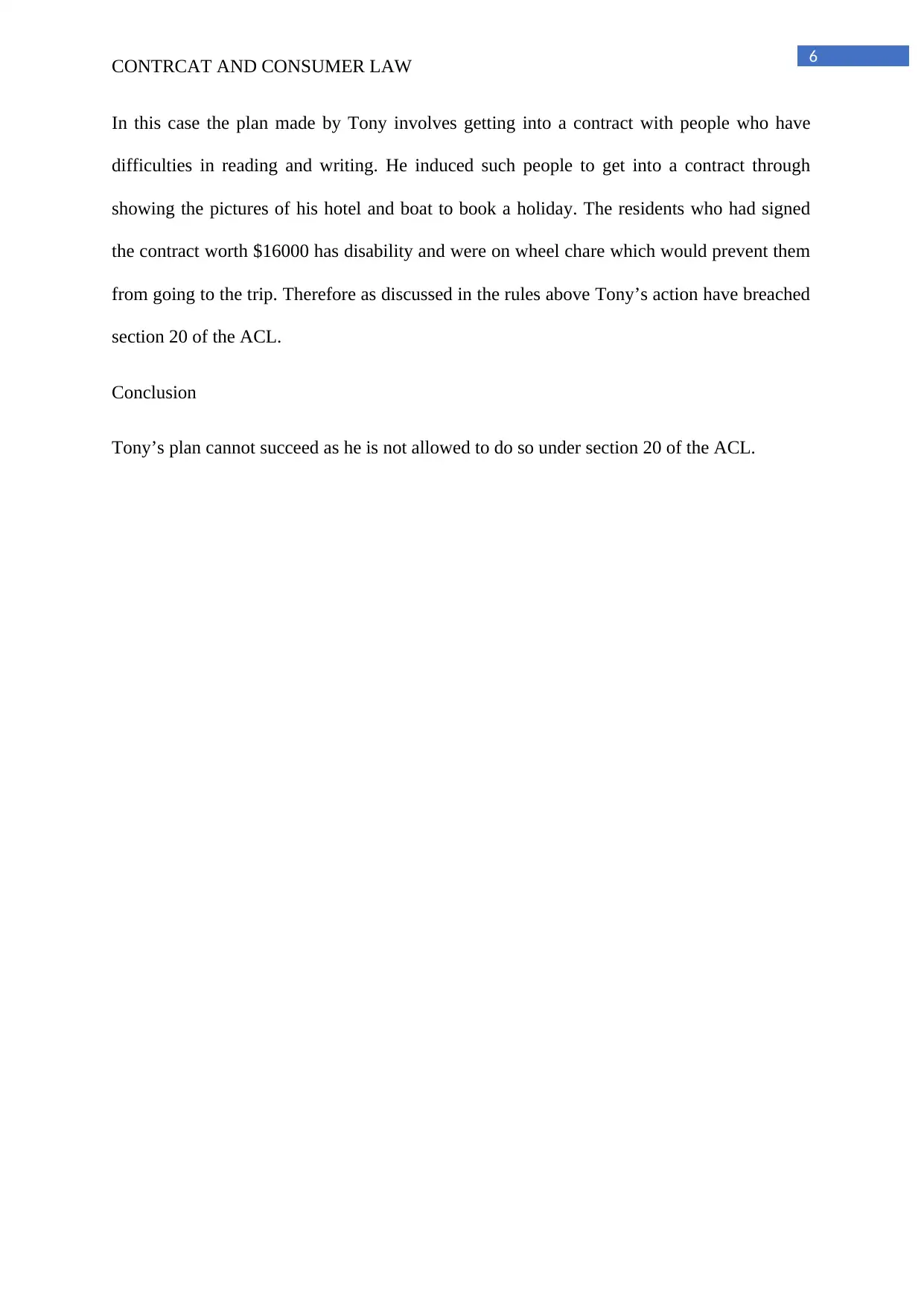
6
CONTRCAT AND CONSUMER LAW
In this case the plan made by Tony involves getting into a contract with people who have
difficulties in reading and writing. He induced such people to get into a contract through
showing the pictures of his hotel and boat to book a holiday. The residents who had signed
the contract worth $16000 has disability and were on wheel chare which would prevent them
from going to the trip. Therefore as discussed in the rules above Tony’s action have breached
section 20 of the ACL.
Conclusion
Tony’s plan cannot succeed as he is not allowed to do so under section 20 of the ACL.
CONTRCAT AND CONSUMER LAW
In this case the plan made by Tony involves getting into a contract with people who have
difficulties in reading and writing. He induced such people to get into a contract through
showing the pictures of his hotel and boat to book a holiday. The residents who had signed
the contract worth $16000 has disability and were on wheel chare which would prevent them
from going to the trip. Therefore as discussed in the rules above Tony’s action have breached
section 20 of the ACL.
Conclusion
Tony’s plan cannot succeed as he is not allowed to do so under section 20 of the ACL.
Paraphrase This Document
Need a fresh take? Get an instant paraphrase of this document with our AI Paraphraser
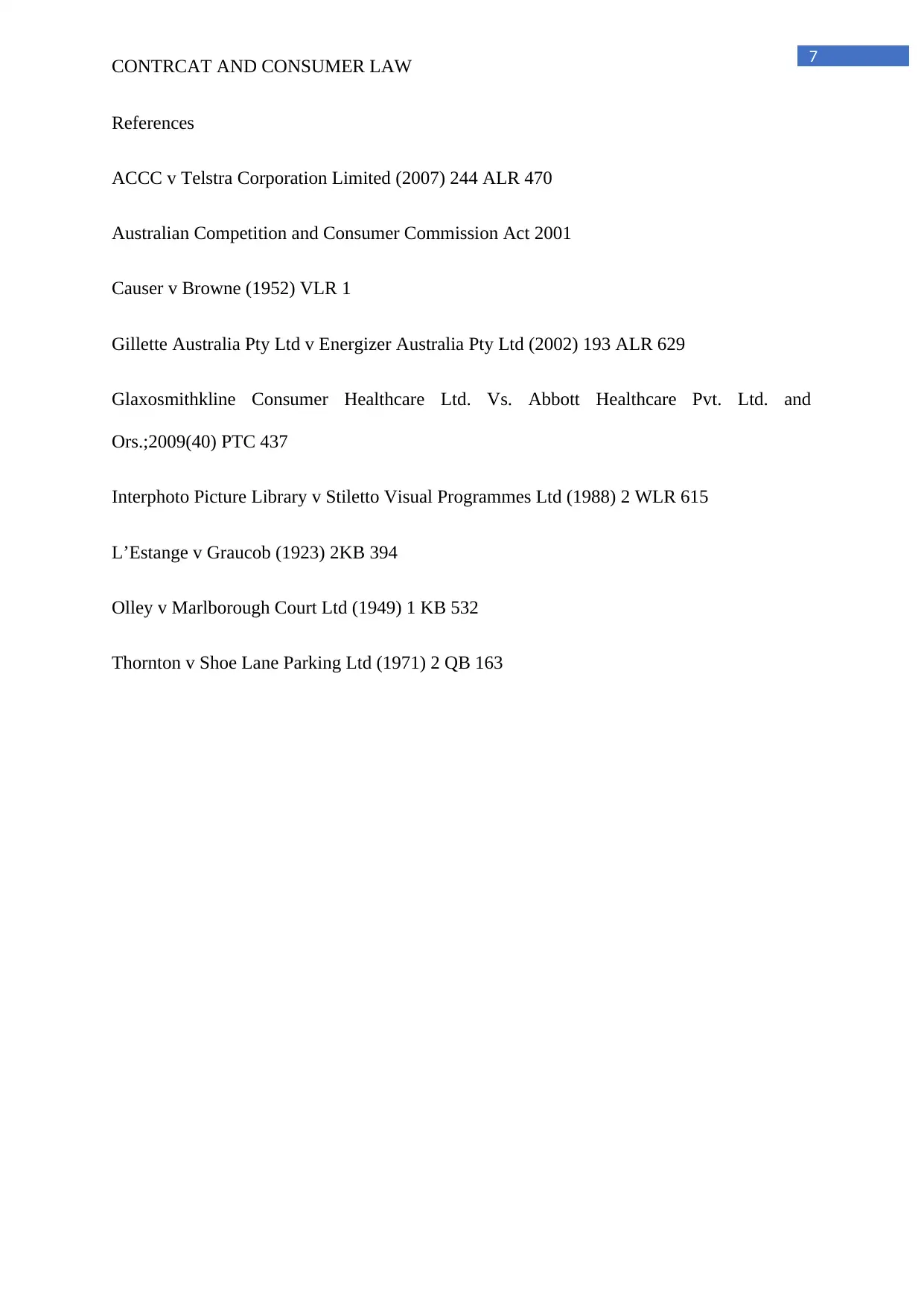
7
CONTRCAT AND CONSUMER LAW
References
ACCC v Telstra Corporation Limited (2007) 244 ALR 470
Australian Competition and Consumer Commission Act 2001
Causer v Browne (1952) VLR 1
Gillette Australia Pty Ltd v Energizer Australia Pty Ltd (2002) 193 ALR 629
Glaxosmithkline Consumer Healthcare Ltd. Vs. Abbott Healthcare Pvt. Ltd. and
Ors.;2009(40) PTC 437
Interphoto Picture Library v Stiletto Visual Programmes Ltd (1988) 2 WLR 615
L’Estange v Graucob (1923) 2KB 394
Olley v Marlborough Court Ltd (1949) 1 KB 532
Thornton v Shoe Lane Parking Ltd (1971) 2 QB 163
CONTRCAT AND CONSUMER LAW
References
ACCC v Telstra Corporation Limited (2007) 244 ALR 470
Australian Competition and Consumer Commission Act 2001
Causer v Browne (1952) VLR 1
Gillette Australia Pty Ltd v Energizer Australia Pty Ltd (2002) 193 ALR 629
Glaxosmithkline Consumer Healthcare Ltd. Vs. Abbott Healthcare Pvt. Ltd. and
Ors.;2009(40) PTC 437
Interphoto Picture Library v Stiletto Visual Programmes Ltd (1988) 2 WLR 615
L’Estange v Graucob (1923) 2KB 394
Olley v Marlborough Court Ltd (1949) 1 KB 532
Thornton v Shoe Lane Parking Ltd (1971) 2 QB 163
1 out of 8
Related Documents
Your All-in-One AI-Powered Toolkit for Academic Success.
+13062052269
info@desklib.com
Available 24*7 on WhatsApp / Email
![[object Object]](/_next/static/media/star-bottom.7253800d.svg)
Unlock your academic potential
Copyright © 2020–2025 A2Z Services. All Rights Reserved. Developed and managed by ZUCOL.




